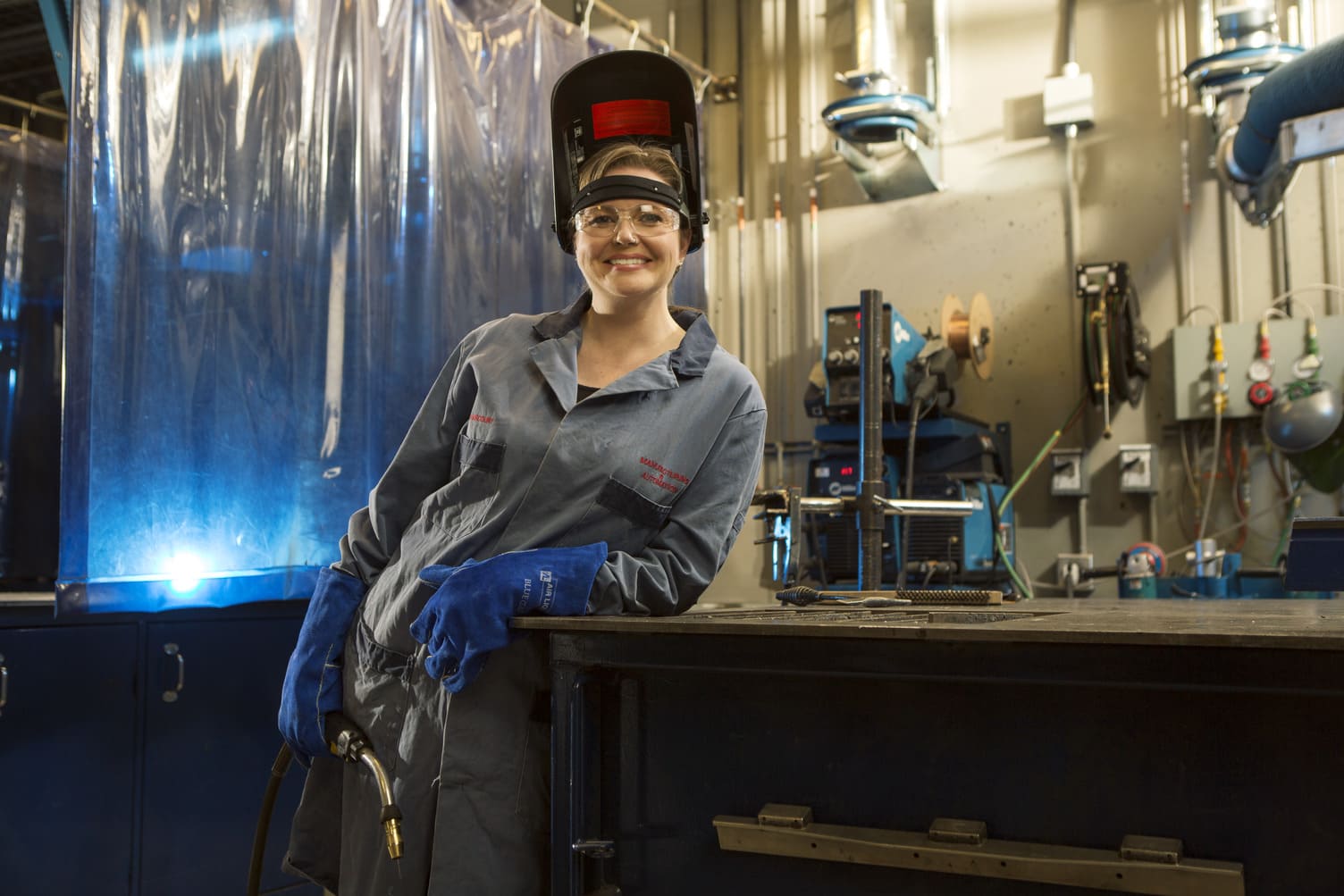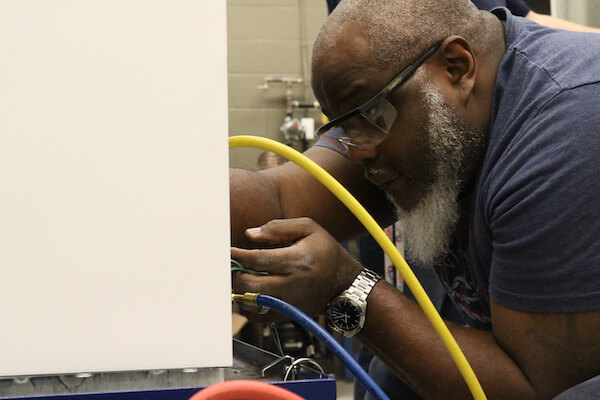On this page:
Overview
Learn to install, service and repair household and commercial appliances.
Appliance service technicians and commercial appliance technicians work across many different work environments, including hospitality spaces, medical facilities, remote camps, transportation hubs and goods and service providers such as airports, railways, grocery stores and bakeries.
As an appliance service technician apprentice, you’ll learn to:
- interpret customer or user observations
- access manufacturers’ service manuals and bulletins
- use specific tools and testing devices to locate issues
- take apart, clean and replace parts to maintain appliances
- communicate with customers or on-site managers
- prepare work orders and complete reports for billing
- maintain records for parts inventories and future service calls.
Certification is required to work in this trade. This means that you must either be a registered apprentice working under the guidance of a certified journeyperson or be an accredited journeyperson yourself.
Appliance service technicians are self-motivated, independent and enjoy helping people. If you like problem-solving and working with your hands, you’ll excel in this line of work.
As an appliance service technician apprentice and journeyperson, you should:
- pay attention to details and produce quality work
- enjoy finding solutions to complex challenges
- have an interest in new technologies
- enjoy providing good customer service
- have good eyesight and colour vision
- be committed to adhering to health and safety protocols.
Upon successfully completing the required working hours and technical training periods, you’ll be awarded a General Appliance Service Technician diploma or Appliance Service Technician - Commercial Appliance Service Technician certificate in addition to journeyperson status by Alberta Apprenticeship and Industry Training.
Careers and opportunities
Our graduates may work in the following occupations. Some careers require additional experience and education.
Associated National Occupational Classification (NOC) codes: 22310, 22311, 22312, 70012, 72011, 72014, 72200, 72201, 72204, 72205, 72421, 73200, 94201.
Apprenticeship training
The term of apprenticeship for an Appliance Service Technician is three years (three 12-month periods), including a minimum of 1,600 hours of on-the-job training each year and eight weeks of classroom instruction at SAIT each year.
Year 1 | Period 1
You’ll start by learning standard workplace safety, equipment and materials. Additionally, you’ll cover electricity, electronics, conductors, insulators, codes, mechanical and gas, as well as alternating current fundamentals.
Training length: 8 weeks
Year 2 | Period 2
You’ll learn about alternating current applications, appliance components, appliance operating principles and appliance troubleshooting.
Training length: 8 weeks
Year 3 | Period 3
You’ll learn about refrigeration and refrigeration components, air conditioning appliances, maintenance, troubleshooting, repair, and system component replacement.
Training length: 8 weeks
The term of apprenticeship for a Commercial Appliance Service Technician is two years (two 12-month periods), including a minimum of 1,600 hours of on-the-job training each year and eight weeks of classroom instruction at SAIT in each of the first two years.
Year 1 | Period 1
You’ll start by learning standard workplace safety, equipment and materials. Additionally, you’ll cover electricity, electronics, conductors, insulators, codes, mechanical and gas and alternating current fundamentals.
Training length: 8 weeks
Year 2 | Period 2
You’ll learn about alternating current applications, appliance components, appliance operating principles and appliance troubleshooting.
Training length: 8 weeks
Apprenticeship education performance
You must pass each section of the course and the AIT exam to succeed in apprenticeship education.
The passing grade for each period is no less than 50% in each course, with no less than a 65% average overall. A passing mark on each provincial exam and the interprovincial qualification (Red Seal Exam) is 70%.
View Alberta's Apprenticeship and Industry Training procedures
Training pathways
You can earn your journeyperson designation in the following way.
The traditional training pathway begins with finding a job with an employer willing to indenture you as an apprentice. Once you’re an apprentice, you’ll alternate between on-the-job training and educational periods.
You must apply for an apprenticeship through Alberta Apprenticeship and Industry Training before attending your first education period at SAIT.
Admission requirements
To enter an apprenticeship, you need the educational qualifications or recommended education for the trade to which you apply.
Alberta Apprenticeship and Industry Training sets and monitors entrance requirements.
Minimum requirements
Successful completion of the following courses:
- English 20-2
- Math 20-3
- Science 10
OR
A pass mark in all five Canadian General Educational Development (GED) tests
OR
Alberta Apprenticeship and Industry Training entrance exam.
Recommended requirements
Apprentices with an Alberta High School diploma that includes the following courses:
- English 30-2
- Math 30-3
- Physics 30 OR Chemistry 30 OR Science 30
- Related career and technology studies (CTS) courses

MyTradeSecrets
Once you have begun working as an apprentice, you can attend SAIT to complete your technical training.
You'll register for technical training at SAIT on MyTradeSecrets or you can register by phone.
Transfer agreements
At SAIT, we evaluate post-secondary credit you have previously earned and apply it to your SAIT credential. Explore our formal transfer agreements available for this program.
We can evaluate your prior education, even if we don't have a formal agreement in place.
Submit a transfer credit application
There are no formal transfer agreements currently in place for this program.
Transfer options for graduates
Build on the knowledge you’ve learned at SAIT. The opportunity to advance your education at an accredited post-secondary institution may be available.
🔗 Visit Transfer Alberta search tool for all transfer agreements in Alberta (including UCalgary, MRU and BVC).
If there are transfer agreements with other institutions outside of Alberta, nationally or internationally, they will be listed below.
Thompson Rivers University
- Program name
- Appliance Service Technician
- Available credits:
- 57
Thompson Rivers University
- Program name
- Bachelor of Technology: Trades and Technology Leadership
- Available credits:
- 60
Available intakes
Available intakes for the 2024/25 year.
Available intakes for the 2024/25 year.
Costs
2025/26 tuition and fees
The following costs are effective as of July 1, 2025.
Appliance Service Technician
Commercial Appliance Service Technician
This is a bring-your-own-device program with a standard computer hardware and software requirement. See the specific requirements on our computers and laptops page.
Books or modules, along with other items for classes, are approximately $600 per period.
We recommend you don't purchase books or modules ahead of time as they might be outdated by the time you attend classes, and they cannot be returned to the Bookstore.
This program requires personal protective equipment (PPE), which may be an added cost.

Funding options for apprentices
Apprentices get to learn while they earn, but there are still costs to consider. Many resources are available at SAIT and federally to help support apprentices.
Information sessions
Prepare for a strong start in your chosen program or get the details you need to decide your future path.
Our expert staff and faculty are ready to answer your questions and provide information about the following:
- What sets SAIT apart
- An introduction to the program and area of study
- Admission requirements
- Future career paths
- Information on the earning potential and graduate employment rates.
Contact
Have more questions?
Apprenticeship training and registration
Apprenticeship and Industry Training Client Services

Oki, Âba wathtech, Danit'ada, Tawnshi, Hello.
SAIT is located on the traditional territories of the Niitsitapi (Blackfoot) and the people of Treaty 7 which includes the Siksika, the Piikani, the Kainai, the Tsuut’ina and the Îyârhe Nakoda of Bearspaw, Chiniki and Goodstoney.
We are situated in an area the Blackfoot tribes traditionally called Moh’kinsstis, where the Bow River meets the Elbow River. We now call it the city of Calgary, which is also home to the Métis Nation of Alberta.
